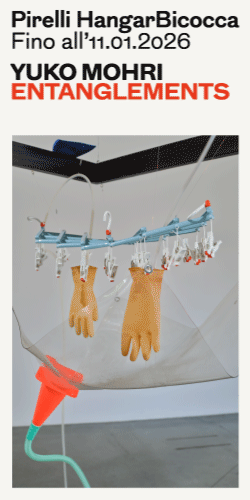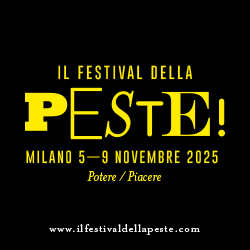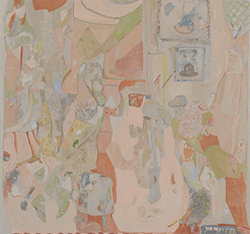

alluminio, ferro, legno, cavo d’acciaio, e-bow, suono
750 x 145 x 20 cm

750 x 145 x 20 cm






La ricerca artistica di Roberto Pacì Dalò è talmente densa, stratificata e mai davvero ripetitiva che disseminarla senza nessun ordine gerarchico né soprattutto cronologico, è forse l’unico modo possibile di presentarla.
Ecco perché Time Line è un titolo impeccabile: riflette il pensiero compositivo di un percorso antologico in uno spazio articolato come Marsèlleria, ma rappresenta anche un ottimo modello di fruizione. È un viaggio nel corso del tempo di Roberto Paci Dalò ed è il miglior modo possibile di guardare e ascoltare la sua stessa mostra.
Per lui è un principio ordinatore (forse anche l’architettura per una memoria futura), per noi è un suggerimento indispensabile: quello che conta è quello che si prende, senza l’obbligo di dovere prendere tutto forzatamente; suoni e immagini circolano liberi nello spazio, e sono destinati prima o poi a riaffiorare.
C’è un aspetto formidabile ma anche perverso per un artista che sceglie di lavorare soprattutto con il suono: sta nel conoscere bene il fatto che probabilmente il pubblico porterà via con sé solo una parte del tutto. Qualcosa che risuonerà come un’impressione, come il ricordo di una sensazione. Anche se dovesse irrompere l’emozione infatti, l’ascolto sarà comunque parziale e completamente soggettivo, assolutamente irriproducibile nella sua interezza, e nulla sarà in nessun modo registrabile (o fotografabile). Roberto Paci Dalò lo sa molto bene e giustamente estende questa condizione percettiva alla totalità del suo lavoro. Non a caso, si rifiuta di presentare i propri video in monitor: le loro cornici rischierebbero di rinchiudere qualcosa che è per natura evanescente e destinato a vagare libero, tanto nello spazio fisico quanto in quello mentale.
Così in Time Line troviamo disegni – che precedono opere che forse avranno luogo – libri, sculture, installazioni, video, ma una sola grande figura che comprende e raccoglie un dispiego di mezzi e di linguaggi apparentemente disparati: la radio. La radio è probabilmente la grande ossessione di Roberto Paci Dalò. È il medium che frequenta da sempre e con maggiore continuità, ed è sia distribuito fisicamente sia evocato ovunque nello spazio della mostra. Ma nel tempo – il tempo di una biografia artistica, e il tempo del pubblico che la incontra sotto forma di opere – avviene tutto un altro gioco. Nel tempo, il palinsesto è aperto e infinito, e soggetto a qualsiasi ipotesi o modalità di ascolto e di interpretazione. Molto probabilmente nell’atmosfera girano ancora i clangori, i rumori, le voci e i suoni di tutto ciò e di tutti coloro che ci hanno preceduto: eventi, uomini, animali. Girano, riverberano e rimbalzano come eco, anche se ci manca ancora il modo di catturarli tutti. E forse un modo non ci sarà mai. Ma se l’atmosfera è il museo della memoria – di tutta la memoria del mondo – allora una radio è l’unico strumento che potrà mai consentirci di farlo.
Roberto Paci Dalò dà vita a composizioni di suoni e di immagini. Che siano flussi di coscienza, visioni, narrazioni o pulviscolo in sospensione di mondi possibili, c’è una cosa che li può eventualmente accomunare tutti: sono irradiati, diffusi, trasmessi. E inevitabilmente destinati a percorrere l’etere per l’eternità.
Andrea Lissoni
//
Roberto Pacì Dalò’s artistic investigation is so dense, layered, and never truly repetitive that divulging it without any hierarchical or above all chronological order is perhaps the only way possible in presenting it.
That’s why Time Line is an impeccable title: it reflects the compositive thinking of a survey itinerary in a complex space like Marsèlleria, but it also represents an excellent model of enjoyment. It’s a journey in the flow of time of Roberto Paci Dalò, and it’s the best way possible to look at and listen to his exhibition.
For him, it is an ordering principle (perhaps even an architecture for future memory), but for us it is an indispensable suggestion: what counts is what we receive, without being obliged to take everything forcedly; sounds and images freely circulate in space and are destined to resurface, sooner or later.
There’s a formidable but also perverse aspect for an artist who chooses to work above all with sound: it resides in knowing well that probably the audience will bring away with it only a part of the whole. Something that will resound like an impression, like the memory of a sensation. In fact, even if it bursts into emotion, listening will nonetheless be partial and completely subjective, absolutely impossible to reproduce in its entirety, and nothing will be in any way recordable (or photographable). Roberto Paci Dalò knows this very well and rightly so he extends this condition of perceiving to the totality of his oeuvre. It is no coincidence that he refuses to present his own videos on monitors: their edges would risk entrapping something that by its very nature is evanescent and destined to freely wander, both in the physical and mental spheres.
Thus in Time Line we find drawings—which precede works that might take place—books, sculptures, installations, videos, but a single large figure that includes and gathers an unfolding of seemingly disparate means and languages: radio.
Probably, radio is Roberto Paci Dalò’s great obsession. It is the medium he has always turned to and with increasing continuity, and is both physically distributed and evoked in the exhibition space.
But over time—the time of an artistic biography and the time of the audience who encounters it in the form of a work—an entirely new game takes place. In time, the program is open and infinite, and subject to any hypothesis or means of listening and interpretation.
In all likelihood, the clangor, noise, voices, and sounds of all that and all those who came before us still linger in the atmosphere: events, people, animals. They move, reverberate, and bounce off like an echo, even though we still aren’t able to catch all of them. And maybe there will never be a way to do so.
But if the atmosphere is the museum of memory—of the entire world’s memory—then a radio is the only instrument that will ever allow us to do so.
Roberto Paci Dalò gives life to sound and image compositions. Be they flows of consciousness, visions, narrations, or dust poised in possible worlds, there’s one thing that may liken them all: they are irradiated, spread, transmitted. And inevitably destined to cross the ether world for eternity.
Andrea Lissoni









